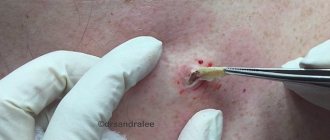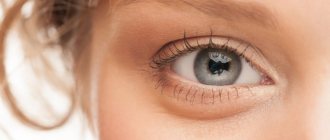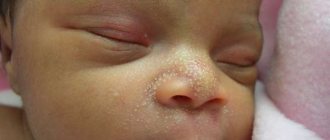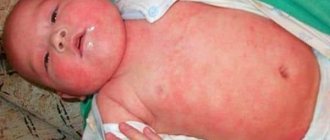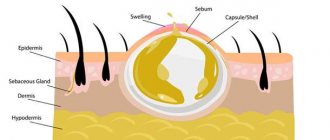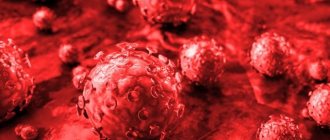Classification
Based on what provokes the occurrence of seizures, several types of this condition are distinguished.
- Angular. Characteristic is the occurrence of an inflammatory process that affects both the inner and outer membranes of the lips and their mucous membrane. Crusts form on the wounds. A child with this type of illness complains of pain when opening his mouth.
- Bacterial. The causative agents are mainly staphylococci and streptococci.
- Fungal. Most often, infection occurs by a representative of the genus Cand >
Coxsackie virus
The causative agent of the disease, the Coxsackie virus, belongs to the genus of enteroviruses. The incubation period of the disease ranges from 2 to 10 days. The disease begins with a sharp increase in body temperature to 39-40°C and above. It is difficult to knock down with antipyretics. At the initial stage of development of the pathology, other signs are usually absent.
Later, the baby develops weakness. He complains of body aches, nausea and cough. On the third day, a rash appears on the child’s body. It is localized near the mouth, on the feet and on the palms. The elements of the rash are small red spots with a diameter of 1-2 mm. Red dots or sores are also found in the child’s mouth. Sometimes they spread to the mucous membrane of the throat, preventing the child from eating. The rash causes itching.
Coxsackievirus can sometimes cause dehydration, iron deficiency anemia, pulmonary edema, myocarditis, viral meningitis and insulin-dependent diabetes mellitus.
Causes
- diseases of the digestive system, in particular dysbiosis;
- the presence of a bacterial infection;
- hypovitaminosis, the reaction will be especially acute if there is a lack of riboflavin or pyridoxine;
- fungal infection;
- weakened immune system;
- allergies to lip cosmetics or medications;
- inflammation of the oral cavity, the presence of chronic diseases of the ENT organs;
- licking lips in cold and windy weather;
- zinc or iron deficiency.
Diagnostics
It is the responsibility of a dermatologist to determine what triggered the appearance of white pimples on the lips. During the examination, the specialist takes into account the parameters of the lesions, the intensity of the development of inflammation, the presence of swelling and other symptoms. Diagnosis is a rather complex process, because there are many reasons.
To clarify the picture, a blood test is performed and a scraping of the upper layer of the epidermis is taken. If there is a suspicion of an exacerbation of a chronic disease, the patient is referred for an ultrasound scan. Based on the test results, a treatment regimen is developed.
Symptoms
General manifestations include:
- the formation of bubbles in the corners where the lips close, slight hyperemia;
- at the second stage, the bubbles burst and cracks form underneath them;
- the wounds begin to heal, but may become inflamed;
- It is difficult for babies to talk and eat because there is pain and burning in the corners of the mouth, because the wounds begin to ooze.
Let's look at how seizures in a child in the corners of the junction of the upper and lower lips are characterized by the bacterial type.
- Lips are red and swollen.
- There are wounds in the corners that have varying depths and may bleed.
- If the baby has a weak immune system, the skin of the face may be damaged.
- When infected with streptococci:
- a bubble with a thin shell is initially formed;
- characterized by transparent content;
- when the transition to an abscess begins, the vesicle becomes yellow;
- after it bursts, it becomes covered with a crust;
- If you open it, it will start to bleed.
- If affected by staphylococcus:
- a yellow bubble forms;
- then a yellow-brown crust will form;
- the wound site will bother the baby;
- causes severe itching.
When fungal infections occur, the following signs are present:
- slight crusts, possibly the presence of thin scales;
- burning sensation, dryness in the corners of the lips;
- the affected area is localized exclusively in one place and does not spread to the entire face;
- A white plaque may form in the oral cavity, which can be removed, but after a short period it will appear again.
If it's measles
The causative agent of measles belongs to the paramyxovirus family. The incubation period of the disease lasts from 9 to 17 days. After it, the first signs of malaise appear. The child becomes lethargic and apathetic, and his appetite worsens. He complains of headache, photophobia and weakness.
When sick, the baby becomes lethargic and apathetic.
Simultaneously with signs of intoxication, catarrhal symptoms appear (cough, sore throat, nasal congestion, hoarseness). Body temperature rises to 38-39°C. On the second or third day after the onset of the disease, the cough becomes rough and barking. The baby's eyelids swell and his eyes turn red. Edema can make the face appear puffy. Small whitish dots appear on the surface of the oral cavity, surrounded by a red area.
After another 2-3 days, rashes appear. The first elements are found on the face and behind the ears. The rash later spreads to the neck, chest, torso, shoulders, thighs and legs. It first looks like small nodules, which gradually turn into large pimples and spots, often merging with each other. The rash may be accompanied by mild itching.
As rashes appear, the child's condition worsens. Body temperature rises even more, catarrhal symptoms intensify. Many children experience enlargement of the cervical, occipital, and sometimes other lymph nodes. The liver and spleen may become enlarged. After 2 days, when the rash begins to fade, the symptoms of measles weaken and the child’s condition returns to normal.
In young children, measles can cause the development of purulent rhinitis, sinusitis, otitis media, bronchitis and pneumonia.
Treatment
Medication therapy includes the following prescriptions.
- Stomatidin. It is an antiseptic, used for rinsing the mouth, and used as a lotion that is applied to jams. Helps destroy both fungal and bacterial infections.
- D-panthenol or Bepanten is used during the healing period of the affected areas. Apply before the antibacterial drug.
- Metrogil Denta. An antibacterial drug that affects the affected areas, both in the oral cavity and around the lips.
- Tetracycline ointment. It also has the desired effect. In addition, it is easily tolerated and does not cause a burning sensation.
- Moderate glucocorticosteroids in combination with antibiotics. Prescribed for severe inflammation.
- Clotrimazole. It is an antifungal drug. It is prescribed if the fungal cause of infection is clearly established.
- Iodine or Fukortsin can be used to cauterize jams. But you need to remember that before this procedure it is necessary to moisturize the affected area with a cream or oil solution.
- Treatment of wounds with Chlorhexidine solution.
- Vitamin therapy.
- Taking immunomodulators.
Traditional methods
Often parents don’t think much about how to treat their child’s seizures. Usually this condition is not given much importance. Parents can rely on traditional medicine. However, in this case it is better to consult a specialist. In addition, you will not be able to accurately identify the cause of the development of this condition; at home, you will not be able to undergo all the necessary tests to make an accurate diagnosis.
What can help in the fight against seizures:
- sea buckthorn or rosehip oil;
- freshly squeezed juice from aloe, cucumber or Kalanchoe;
- decoction of string, chamomile or calendula;
- tocopherol or retinol solution (oil);
- combining butter with propolis or honey;
- strong brew of green tea;
- plantain leaves, crushed into pulp - used to lubricate cracks;
- applying a piece of garlic to the affected area kills germs, however, causes a burning sensation;
- soda solution for washing the sores and oral cavity if they are of fungal origin.
I once had seizures. I don’t know what etiology. They didn't take me to the doctor. The grandmother was engaged in treatment with the help of lotions and ointments of her own making. It helped me, but I wouldn’t take that risk with my child.
How to treat lip jams in children?
The answer to the question of how to treat seizures in a child is not easy, since the disease can be successfully dealt with only with a correct diagnosis, using an integrated approach. Correct diagnosis is necessary not only in order to prescribe adequate treatment, but also in order not to confuse angulitis erosions with herpetic rashes or papules of syphilis. When diagnosing seizures in the corners of a child’s mouth, treatment may include external medications, tablets, vitamins and traditional medicine.
Angulitis - treatment, ointment
For candidal angulitis, the most popular drug is Fukortsin. This raspberry antiseptic solution is used to lubricate the corners of the lips and the skin around erosions 2-3 times a day to prevent the growth of yeast colonies on the face. Ointment for yeast infections:
- Levorin ointment;
- Lamisil;
- Nystatin ointment;
- Teymurov's pasta;
- Sulfur-salicylic ointment (2 percent).
To combat streptococcal anugulitis, a solution of brilliant green is used as a local antiseptic. In combination with brilliant green, antibiotic ointments are used:
- Erythromycin ointment;
- Syntomycin ointment.
In addition to antibacterial and antimycotic drugs, you can use ointments and creams with a healing effect to quickly restore the integrity of the skin:
Medicines for seizures
Streptococcal angulitis rarely requires the use of antibiotics - the use of external agents with an antibacterial effect is sufficient, but in difficult cases, tetracycline can be used. When diagnosed with candidal angulitis, treatment includes taking antifungal drugs, the most popular of which is Fluconazole. The course of treatment with this drug should be at least 10 days, since surviving yeast will very quickly cause a relapse of the disease.
Angulite – vitamins
The correct answer to the question of how to cure seizures in a child necessarily includes a list of vitamins. The drug must necessarily include B vitamins and nicotinic acid (vitamin PP). The preferable option is to choose a balanced vitamin preparation designed for the age of the sick child. Particularly popular:
- Vitrum Kids;
- Centrum Children's Pro;
- Multitabs for children;
- Alphabet.
A balanced diet will help restore the required amount of vitamins in the body as much as possible and cure congestion in the corners of the child’s mouth. The baby's diet should include:
- fresh vegetables, berries and fruits, preferably local seasonal ones;
- grenades;
- avocado;
- greens - salads, parsley, dill;
- red meat;
- buckwheat, brown rice;
- fresh peas and green beans;
- eggs;
- products made from wholemeal flour;
- mushrooms;
- fermented milk products, cottage cheese;
- nuts.
Folk remedies for seizures
Traditional medicine is effective in diagnosing angulitis in children; treatment with pharmaceutical drugs can be supplemented with home remedies:
- Lubricating the area with tea tree, sea buckthorn, rosehip or avocado oil helps to quickly soften the skin and heal erosions. For the same purpose, honey, butter, cucumber juice, aloe or Kalanchoe, as well as the contents of Aevit capsules, can be applied to the wounds.
- An ancient folk remedy for treating stuckness in the corners of the mouth in children is earwax, which is used to lubricate the erosions.
- To disinfect wounds, you can use strong green tea, which is used to wipe the skin in the mouth area and the cracks themselves.
It is extremely unpleasant and annoying if a child develops seizures. This problem is often perceived by others as a result of poor hygiene. But it is not always the case. Seizures can signal an infection in the body or a serious illness.
It is important to start by finding the source of the problem. This is why you should consult a doctor if your child has seizures.
Only a specialist can correctly determine the causes and treatment.
Recommendations
- Monitor your baby's proper nutrition, make sure there are enough vitamins and microelements in his diet.
- Be careful when consuming possible allergens.
- Increase the body's immune resistance, teach your child to harden and exercise.
- Teach your child to always wash vegetables and fruits before eating.
- Teach your child to follow the rules of self-care.
- Make sure that the baby does not put dirty fingers into his mouth or touch his lips.
- At the slightest suspicion of a lack of vitamins, seek help from a doctor.
- Treat diseases in a timely manner, especially chronic forms. If antibiotics are prescribed, do not forget about the drugs that are so necessary to maintain constant microflora, probiotics.
- Visit your dentist on time and prevent advanced conditions in the oral cavity.
Boom knots
Bohn's nodules are small (up to 3 mm in diameter) cysts formed from the rudiments of the salivary glands. They have a spherical shape and are located on the soft palate. One or more similar formations are detected in the baby, but over time they will disappear on their own. The nodules do not cause any discomfort.
The so-called Epstein pearls are similar to the phenomenon described above. These are epithelial cysts located in the midline of the palate, where two plates merge with each other during the prenatal period. Such tubercles are somewhat elongated and filled with keratin masses. After the latter are removed, the white dots on the palate of the newborn dissolve.
General concept
Seizures in the corners of a child’s mouth - photo:
Seizures are small but quite painful cracks that form in the corners of the lips. Initially, irritation and redness form on the affected areas of the skin. Then a small wound appears - a crack.
Over time, in the absence of therapy, erosion occurs at the site of the crack - a more extensive painful wound. Crusts may appear at the site of erosion and bleeding may develop.
The child feels severe discomfort, which intensifies when talking or eating food, especially spicy or salty.
Neonatal teeth
The teeth that a child has at birth, without the presence of additional anomalies, are a feature inherited in an autosomal dominant manner. They mainly appear on the lower jaw in the incisor area. Congenital teeth have a smooth surface or differ from normal teeth in roughness and discoloration. They have a shorter root, which gives much greater mobility.
Almost all neonatal teeth are further included in the series of primary teeth. But in some cases they become additional (supernumerary), and therefore require removal. In addition, the appearance of congenital teeth is sometimes a sign of quite serious genetic abnormalities.
Terminology
The appearance of painful areas on the skin of the lips is called differently. In medical terminology, it is common to use names such as cheilitis or angulitis. However, these 2 concepts have certain differences.
Cheilitis is dryness and flaking of the lips, painful areas appear in the area of the border of the lips, in the corners of the mouth. The mucous membrane of the lips is also affected. Angulitis is the formation of cracks in the corners of the mouth, other areas remain unchanged.
Read about the symptoms and treatment of aphthous stomatitis in children here.
Why does it happen?
Many pediatric studies have proven that the skin and mucous membranes of newborns are thinner than those of adults, so babies often encounter rashes of different locations, including in the lower or upper lip. In a child, yellow or white small pimples may be the result of disorders of certain internal organs and systems. If acne appears inside the mouth or outside the lip, this may indicate the influence of such factors:
- dermatitis of various types and severity;
- use of low-quality or unsuitable epidermal care products;
- a constant urge to put fingers or other dirty objects in your mouth;
- diseases of viral or bacterial origin;
- cold;
- hormonal changes;
- insufficient hygiene procedures or their absence;
- anatomical features of the body, as a result of which the sebaceous glands are displaced;
- narrowing of the ducts and blockage of the glandular channels;
- mechanical damage in the lip area.
Return to contents
Causes
The appearance of bumps in the corners of the mouth is caused by a bacterial infection.
The main causative agent is a fungus of the genus Candida, or streptococcal infection .
However, even when infected with these microorganisms, the appearance of jams is not always possible.
The disease appears when a pathogenic fungus, having entered the human body, is activated and begins to multiply intensively. This requires the presence of certain unfavorable factors , which include:
- weakened immunity;
- iron deficiency conditions;
- lack of vitamins (especially B vitamins);
- increased salivation, which contributes to constant irritation of the skin of the lips;
- tendency to allergic reactions;
- failure to comply with oral hygiene rules;
- diseases of the oral cavity (gingivitis, caries);
- diabetes;
- damage to the skin of the lips;
- inflammatory processes in the body;
- chronic diseases;
- pathologies of the gastrointestinal tract, digestive disorders.
What to do if an abscess appears on a child’s gum? Find out the answer right now.
Local diseases
The cause of white rashes is stomatitis, which manifests itself in different forms:
- Aphthous - the cause of its appearance has not been identified; it occurs in acute, chronic and recurrent forms. The disease is characterized by the appearance of many aphthae (ulcers) of irregular shape, leading to difficulties in eating. Healing is long and sometimes lasts several months.
- Candidiasis - most often found in newborns. The white pimples in the mouth gradually merge, and the entire cavity becomes covered with a whitish coating.
- Herpetic - unlike previous forms, the sores are pinkish or red in color and have a watery structure. In addition to the oral cavity, the lips are also affected. It occurs in children from one and a half to three years old. The mild form can be treated at home, while the severe form can be treated in a hospital.
- Allergic – provoked by allergens: plant pollen, household dust, animal hair, etc. By removing the source of the allergy, stomatitis stops.
- Bacterial – develops due to the penetration of pathogenic microflora (staphylococci, streptococci) into existing wounds in the oral cavity.
We suggest you read: The right side of the head is numb: reasons, what to do
Symptoms of pathology
Seizures appear gradually in a child, the symptoms of the disease appear in a certain sequence :
- Irritated, reddened areas appear in the corners of the lips.
- After a few hours, a small bubble filled with transparent contents forms in this place.
- The bubble bursts, and a small wound appears in its place, which periodically bleeds.
- The wound increases in size, turning into a crack.
- The redness intensifies.
- There is swelling and swelling of the skin in the affected area.
- Over time, a dry crust appears in this area, which cracks and bleeds even with minor exposure.
Throughout the development of the pathology, the child feels severe discomfort, pain, and burning. These sensations intensify when you try to open your mouth, or when licking the affected area.
Danger of meningitis
Meningitis is one of the most dangerous diseases
One of the most dangerous diseases accompanied by a rash is meningitis. Its causative agents are numerous bacteria (meningococci, pneumococci, group B streptococci), as well as viruses, fungi and protozoa. They cause inflammation of the membranes of the brain and spinal cord.
In the first hours of the disease, body temperature rises to 39-40°C. The child becomes weak, lethargic and drowsy. He complains of a severe headache. Pain is caused by pressing on the forehead, on the wings of the nose and on the eyeballs with closed eyelids. Later, vomiting appears, which is not accompanied by nausea and does not bring relief. The baby develops photophobia and is irritated by sounds.
The rash is more typical of bacterial meningitis. The spots are red or red-violet in color and do not rise above the surface of the skin. They look like small hemorrhages that do not fade when pressed. This feature is a characteristic sign of meningitis. The rashes are localized mainly on the lower and upper extremities, as well as on the sides of the child. Any touch to the skin causes discomfort in the baby.
Meningitis can cause serious disorders that lead to disability of the child. Therefore, its treatment must be started immediately.
Treatment methods
How to treat? If you notice the first signs of cracks in the corners of the mouth, you should not let the situation take its course ; you must show the child to a doctor as soon as possible. The doctor will determine the presence of the disease and identify the cause of its development.
This is very important, because if the cause is not eliminated, further treatment will not give the expected effect. Treatment of pathology is medicinal, includes taking medications and using products for external use.
Traditional medicine recipes can also be used as auxiliary treatment methods
What does geographic language mean in a child? Read about it here.
Medications
External products
Seizures must be treated not only from the inside, but also from the outside. To do this, use various local remedies (ointments, creams).
In particular, a solution of furatsilin to disinfect the wound , Bepanten to accelerate regeneration processes, Levomekol or Tetracycline ointment to prevent secondary infection.
Traditional medicine recipes
Various folk recipes are widely used to treat seizures:
- Bee honey is applied to the affected areas of the skin once every 2-3 hours, with a break at night. The course of treatment is 1 week. When applying honey, the child may experience minor discomfort; this is considered normal.
Recommendations from pediatricians for the treatment of scrofula in children can be found on our website.
For stomatitis
- If the cause of white spots on the gums is aphthous stomatitis, it is important to give the child plenty of fluids, rinse the mouth, humidify the air in the room and change the baby’s menu (give warm, fresh liquid or pureed food). The doctor may prescribe the child antihistamines, antibacterials, multivitamins, immunomodulatory or antiviral medications. Local treatment of afts is carried out with analgesic gels and antiseptic solutions.
- If white spots appear as a result of herpes stomatitis, it is important to isolate the child from other children, since this disease is highly contagious. The room in which the baby is located is constantly ventilated, and dishes and towels should be separate. For treatment, you should consult a doctor so that he can prescribe an antiviral agent that is effective for such stomatitis. Additionally, the treatment uses gels with an anesthetic effect and frequent rinsing with herbal decoctions and antiseptics.
- If changes in the gums are associated with candidiasis infection, it is important to numb the affected areas of the gums, change the baby’s diet (exclude hard, sour and hot foods) and rinse the mouth with a soda solution. If this form of stomatitis is confirmed, the doctor will prescribe antifungal medications based on fluconazole or nystatin.
Nutritional Features
Since a common cause of seizures is considered to be a lack of vitamin B2 , it is necessary to ensure that the child’s daily diet includes foods rich in vitamin B2.
These foods include red meat (for example, lean beef), eggs, organ meats, dairy products, greens, grains, fruits and vegetables.
And it is better to avoid eating sour, spicy or salty foods, as they provoke irritation of the mucous membrane and skin of the lips, which further aggravates the situation.
Prevention
It is not difficult to follow rules that will reduce the risk of developing seizures. To do this, it is necessary to offer the child a variety of healthy dishes, strengthen the baby’s immunity, and protect him from various types of viruses and infections.
It is also important from childhood to teach a child to take care of the oral cavity and observe the rules of personal hygiene.
Seizures - unpleasant and painful cracks in the corners of the lips - are not only an aesthetic problem.
The formation of a jam may indicate the presence of certain health problems .
The danger of the disease lies in the fact that the affected areas of the skin become entry points for various types of infections. Therefore, when the first signs of pathology appear, it is necessary to show the child to a doctor.
Seizures in children - what do you need to know? Tips for parents in this video:
We kindly ask you not to self-medicate. Make an appointment with a doctor!
Seizures in the corners of the mouth in children, or angulitis, is a disease that causes inflammation, burning, soreness and itching, making it difficult to eat. Seizures in a child can indicate a number of problems with the baby’s health.
Types of pimples in a child’s mouth with photos
The appearance, location and accompanying signs of pimples on the mucous membrane depend on the cause of their occurrence and the advanced stage of the disease. This should include the general health of the baby. The same pathology is more pronounced in sick children than in children with high immunity.
There are many types of rashes in the mouth (we recommend reading: rash on the palate of a child’s mouth: causes and ways to eliminate it). In the photo of the affected oral cavities, you can notice the external diversity of the pathology. Types of pimples that can affect the mucous membrane:
- ulcers,
- dense nodules or internal pimples,
- plaques,
- bubbles,
- spots with a rough or smooth surface.
Inside, ulcers or blisters are usually filled with clear or cloudy liquid, sometimes mixed with blood. If left untreated, pus may appear in their cavities, which indicates the onset of an abscess. It is prohibited and dangerous to puncture pimples yourself, especially if there is pus. In almost every case, changes in the condition of the mouth occur:
- the color of the mucous membrane changes,
- swelling or inflammation appears,
- the temperature may rise,
- there is an unpleasant odor from the mouth,
- a dark red inflamed border forms around white or transparent pimples,
- an abnormal white, yellow or gray coating appears,
- the child feels pain or itching, has difficulty eating, drinking or hygiene,
- sometimes the lymph nodes become inflamed,
- salivation is impaired.
What are jams and their symptoms
Cracks in the corners of the mouth are a problem for most children of infant, preschool, and primary school age. The disease is characterized by the appearance of wounds on the skin and mucous membrane near the mouth. Cracks are often subject to trauma, bleeding, and infection.
Skin lesions in the corners of the lips, caused by a combined infection, are called angular stomatitis or angular cheilitis. The latter is manifested by the appearance of small vesicles in the corner of the mouth, which later burst, forming wounds with a crust. The protracted surface often cracks when opening the mouth, laughing, or eating, which complicates the healing process.
Causes of appearance in the corners of the lips
The cause of angulitis may be damage to the skin by streptococcus or a fungus of the genus Candida (Candida). The disease can also provoke:
Traumatic factors
The following factors can influence the development of infection.
- Treatment of dental diseases. Sometimes, during manipulations, the dentist unintentionally injures the skin in the corners of the lips. This occurs when it is necessary to open the oral cavity wide.
- Removable prosthesis. The skin of older people is not as elastic and drier than that of young people. Daily installation and removal of a removable structure requires a wide opening of the mouth, so injury to the skin around the lips cannot be ruled out.
- Change in bite due to missing teeth. Elderly people lose most of their teeth as they age, which negatively affects their bite. Also, the location of skin folds is subject to changes, and stagnation of saliva is observed in the corners of the mouth. Together, this leads to softening of the mucous membrane and skin.
- Other factors: constant yawning, screaming, oral sex, active kissing.
Treatment methods
Before treating jams that occur frequently, it is necessary to find out the cause of their formation. The doctor, based on an external examination, a survey of parents, and laboratory test results, will determine the etiology of the disease and prescribe the necessary therapy.
To diagnose sores in the corners of the mouth in infants and older children, the following is done:
- blood and urine sampling for general clinical analysis;
- oral swab;
- serological test (if congenital syphilis is suspected).
To treat a child's seizure, vitamin and immunomodulatory therapy complexes and the use of medications for external influence on red inflamed spots with microcracks are prescribed. Drugs are prescribed depending on age, the cause of the pathology, the complexity of the course, and the duration of the disease.
In dermatology, ointments are used that effectively fight fungus, streptococcal infections, anti-inflammatory, wound-healing liniments, and disinfecting solutions. For oral administration, complexes of vitamins B, C, E, PP, antifungal drugs in the form of tablets, capsules, antiallergic drugs (tablets, syrups), antibiotics (if streptococcus is detected) are prescribed.
Folk remedies
Use helps with the initial stage of development of pimples; in advanced forms it will not help. This method will last until you visit the dentist.
You can use the following options:
- Homemade methods will last until you visit the dentist. Take equal proportions of sorrel, yarrow, calendula, and dandelion. Grind everything thoroughly. Add vegetable oil, mix well. Apply 3 rubles to areas affected by pimples. in a day.
- Take 1 tbsp. l. chamomile, pour boiling water (2 cups), leave for 3 hours. Apply to areas affected by pimples with a cotton swab soaked in the solution. If you don’t have chamomile, you can replace it with calendula, it will perfectly help with illness.
- Grind the onion, add 10 tablets. mumiyo, 1 tbsp. l. olive oil. Mix thoroughly, moisten a piece of bandage and apply to the sore area.
- Take 15 grams. calendula and strawberries, pour boiling water over them and leave for a day. Moisten a cotton wool (bandage) in the resulting solution and place it on the damaged area. Keep for at least 40 minutes, if necessary, take another bandage. Use until pain disappears.
- Twist aloe and Kalanchoe leaves in a meat grinder. Mix with finely chopped garlic clove. Apply the mixture to the problem area for 10 minutes.
Something to remember! The listed recipes have a local effect on pimples; they should not be used as independent healing, because the consequences may be different: for some it will help quite effectively, for others it will not.
You should not assume that pimples that appear are harmless and will not cause trouble. They cannot be heated, squeezed out, or subjected to mechanical stress.
This will lead to an increase in germs, and the infection will spread quite quickly. Small children often suffer from them, so parents need to be attentive: carefully examine them, monitor their personal hygiene.
We suggest you read: Getting rid of cracked tongue
Something to remember! A small, inconspicuous pimple will eventually develop into an abscess, and it will damage not only the oral cavity, but also the brain, and this is very scary!
The occurrence of pimples can be prevented by doing the following:
- Young children often suffer from complications, so parents need to be careful: carefully examine them, monitor their personal hygiene. Eat only thermally processed food.
- Use well-washed foods.
- Visit the dentist regularly (at least once every 6 months).
- If neoplasms or ailments are detected, immediately go to an appointment with a dentist, who will identify the diagnosis and carry out treatment procedures without complications.
- After each meal, thoroughly clean the mouth.
- Follow the advice and recommendations.
- Consume foods that contain vitamins (minerals) in large quantities.
- Eliminate foods containing dyes from your menu.
- Do not overuse harsh, spicy and salty foods.
- Carry out regular wet cleaning in your apartment.
- Ventilate the room.
Review of effective ointments
You can quickly cure wounds by paying attention in time to the appearance of redness and peeling on the lips, correctly identifying the causative agent of the disease, and using an effective drug from the pharmacy against it.
Ointments that will help in the treatment of sores in the mouth:
| Medicine | Description |
| Tetracycline ointment | An antibacterial agent, a broad-spectrum antibiotic that destroys bacteria and prevents their further development. Not applicable to children under 11 years of age. |
| Clotrimazole | Broad-spectrum antifungal cream. Apply a thin layer 2-3 times a day. Contraindicated in children under 3 years of age. |
| Trimistin | A combined remedy that relieves inflammation, allergic manifestations, and itching. It is an antibacterial, antifungal agent. The drug has received positive reviews in the treatment of angulitis. Contraindicated for herpes rashes on the lips, chickenpox, the causative agent of which is the herpes virus, for syphilitic lesions, and skin cancer. Use for children as prescribed by a doctor. |
| Metrogil-denta gel | Antimicrobial, antibacterial drug. The gel can be used to treat the manifestations of cheilitis on the lips and the cause of the problem, which is gingivitis, periodontal disease, stomatitis, and other inflammatory processes in the oral cavity. Can be used by children over 6 years old. |
| Miramistin | Has bactericidal and antifungal effects. Prevents infection of wounds around the mouth that have begun to peel and crack, and promotes the regeneration of affected skin. Before anointing your child's wounds, you should consult your doctor. |
| Erythromycin |
In combination with pharmaceutical drugs for the treatment of angular stomatitis and cheilitis at home, folk methods are used using a soda solution for rinsing, treating the corners of the mouth after each meal (1-1.5 teaspoons of soda per glass of warm water). It would not be amiss to lubricate the affected area with aloe juice several times a day, and make lotions from decoctions of chamomile, calendula, string, sage, and oak bark.
How to recognize jams
Seizures appear as small redness in the corners of the lips, then the skin becomes rougher and begins to crack. If the disease is detected at an early stage, then solving the question of how to treat jams in the corners of a child’s mouth will take a maximum of a couple of weeks.
In advanced cases, the jams begin to become inflamed, crusts appear, and even small bleeding ulcers appear. It becomes painful for the child to open his mouth again, problems with appetite begin, and it is difficult to answer in class.
Why do jams appear?
Traditional and modern medicine has long been familiar with such a disease as jams in the corners of the mouth in children - their causes and treatment are well known, and various recipes for getting rid of angulitis are very successfully used.
Here are the main reasons that provoke the appearance of cracks near the lips:
- lack of vitamins, primarily riboflavin - B2, or pyridoxine - B6;
- weakened immune system;
- dysbacteriosis and other diseases of the gastrointestinal tract;
- deficiency of zinc and iron in the children's body;
- allergies to medications or hygienic lipstick;
- constant licking of lips;
- inflammation of the respiratory tract and diseases of the oral cavity;
- bacterial infection.
Video:
Seizures in the corners of the mouth in children: traditional treatment
Since the most common reason for the appearance of cracks is a child’s weak immunity and lack of nutrients, seizures most often occur in early spring, during the period of vitamin deficiency.
In some cases, they quickly disappear on their own, but mostly parents are faced with a serious problem - how to cure jams in the corners of their child’s mouth.
To begin with, it is important to decide which vitamin or element the child is missing. For example, a deficiency of B vitamins can be signaled by dry skin, brittle nails in children, and split ends.
In such cases, you can start taking special children's vitamin complexes; they will also help compensate for the deficiency of iron and zinc. It’s best to start by consulting with your pediatrician about which particular complex is right for your child.
Be sure to adjust your diet - if jams occur in the corners of the mouth in children, treatment should include proper nutrition. The best sources of vitamin B2 are dairy products, eggs, beef and liver, B6 - fish, cereals, brewer's yeast.
Cottage cheese dishes, omelets, buckwheat and millet porridge and beef cutlets - be sure to include all this in your child’s diet. Red meat, buckwheat, porcini mushrooms and eggs are rich in iron. It is best absorbed in the company of vitamin C - parsley and dill, fresh vegetable salads and fruits.
Children often develop a bacterial infection, the causative agent of which is staphylococcus or streptococcus. How to treat jams in the corners of the mouth in children in such cases?
Doctors recommend lubricating the cracks with an alcohol solution or fucorcin 2-3 times a day, and topped with ointments: D-panthenol (choice of cream or ointment), tetracycline ointment, Teymur’s paste, levomekol and some others.
The main condition is to continue treatment for several more days after the symptoms disappear, otherwise unpleasant seizures will reappear over time.
Seizures in the corners of the mouth in children: alternative treatment
Traditional medicine has also accumulated many effective recipes on how to treat jams in the corners of a child’s mouth.
Here are the most popular:
- One of the classic, but rather controversial methods is earwax. Use a cotton swab to remove it from the ear and apply it to the inflamed cracks. The obvious effect is visible within 3-4 days.
- This sweet recipe is suitable for small children - grate an apple on a fine grater and mix it with melted butter in equal proportions. Apply on wounds several times a day. A good option for the night: honey + butter.
- Juice of medicinal plants - aloe, celandine, Kalanchoe.
- Oils also help in the treatment of angulitis: liquid vitamins A and E, sea buckthorn and olive oils. Avocado and tea tree oils are effective in combating cracks in the corners of the lips.
- The universal healer - propolis - also copes well with jams. Mix it with softened butter in a ratio of 1:10, heat it in a water bath and make lotions.
- And the simplest and most accessible folk recipe is an already brewed bag of green tea. Apply it to the wounds and hold for 20-30 minutes.
Video:
PS Now you know how to deal with the problem at home.
